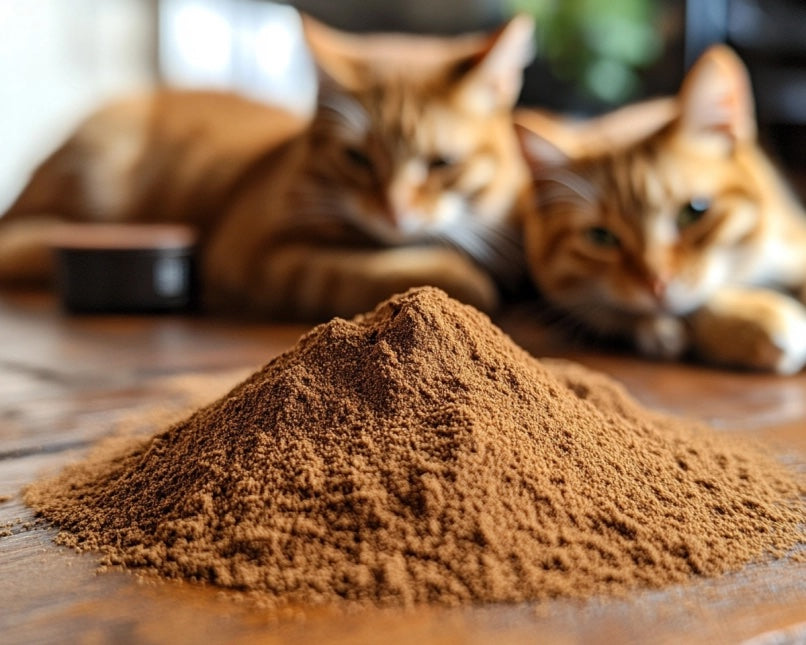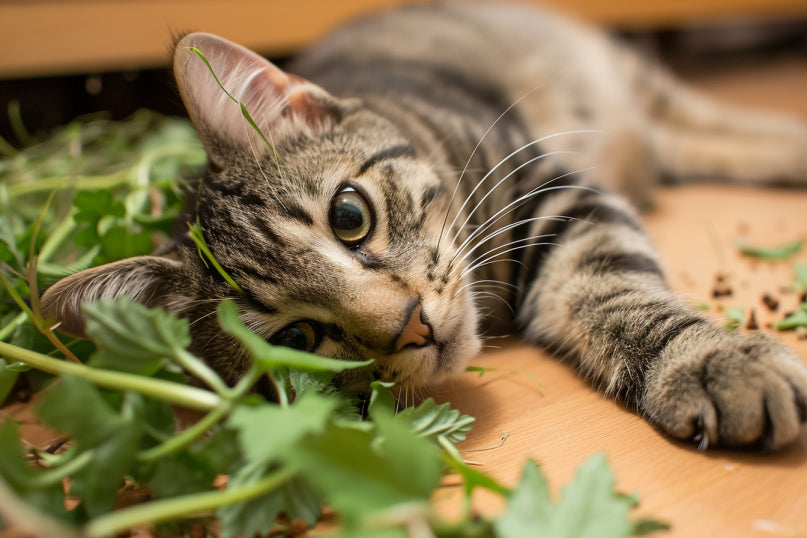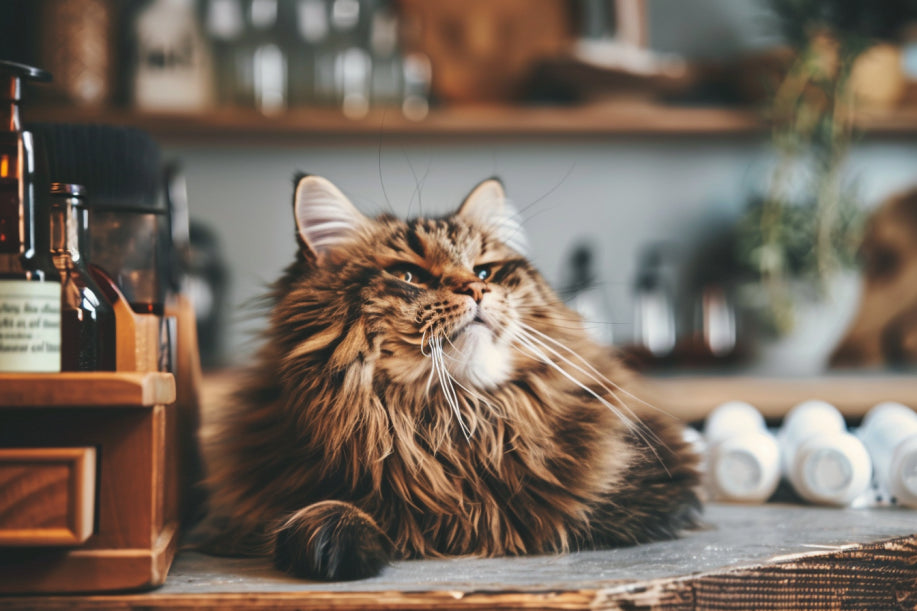
When you hear the word salami, you probably think of “Italian sausage".
But salami is everything. No, seriously, it’s a generic term for any sort of encased meat. It can be made with different cuts or spice mixes. While salami is usually eaten uncooked, it isn’t raw. It’s actually cured in a process similar to aging cheese.
For us, salami makes a tasty pizza topper or spicy sub stuffer. But have you ever wondered whether your cat can have a little salami? Sara Ochoa, a veterinary consultant for DogLab, says, “You can give your cat a thinly-sliced piece of salami as a treat.”
When is salami good for cats to eat?

Cats are obligate carnivores — which means that they must eat meat to live.
If their diet doesn’t have enough protein, they’ll break down their own muscles and organs. Believe it or not, a thin piece of salami has two grams of protein.
It also has an amino acid called Taurine. Taurine-depleted cats can go blind or have dilated cardiomyopathy (DCM). DCM makes your cat’s heart muscle weak and enlarged, so it can’t pump enough blood to the rest of his body.
Salami is roughly 75 percent fat. “But cats need fats in their diets because they’re used for energy. They also help the body absorb fat-soluble vitamins, A, D, E, and K,” Ochoa says. It contains a mineral called selenium, an antioxidant that protects your cat’s cells from free-radicals. These unstable atoms attack your cat’s organs and joints, causing arthritis, autoimmune disorders, and cancers.
Did you know that about 33 percent of cats will experience kidney problems in their lifetime? Dehydration can lead to kidney disease, heatstroke, and diabetes. “Since salami has higher salt content but isn’t toxic, it would cause your cat to want to drink water,” Ochoa says.
When is salami bad for cats to eat?
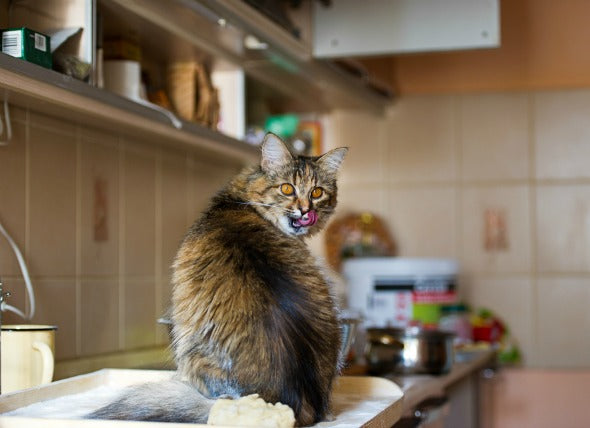
Most of the time, too much salami is going to hurt your cat. There are 149 grams of sodium in a thin slice of salami. “The toxic dosage of salt for a 10-pound cat is 30 grams,” Ochoa says. “That’s a little over a tablespoon of salt.” But a two-year study in the Journal of Veterinary Medicine showed that extra salt won’t raise your cat’s blood pressure or damage his kidneys.
Salami is often made with garlic, onion, mustard seed, and red chili peppers. Mustard seeds and chilis can cause your cat to have diarrhea, vomiting, bloating, and stomach pain. Garlic and onions can cause his red blood cells to rupture, causing anemia and, in severe cases, organ failure or even death. It takes about 1 teaspoon of onion and 1/2 teaspoon of garlic to harm your cat. “Most of these ingredients are safe in small amounts,” Ochoa says.
Can cats get salmonella poisoning from salami?
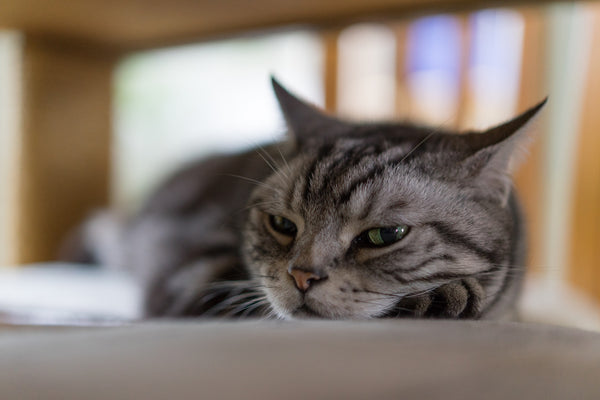
Salami has been a culprit of Salmonella poisoning in the past (one outbreak in 2009 sickened 272 people). However, it’s rare in cats. In a 2017 study published in the Journal of Clinical Microbiology, almost 550 stool samples from cats were collected from across the country. Less than one percent tested positive for salmonella.
Salmonella poisoning causes mucousy diarrhea, vomiting, weight loss, dehydration, and fever. In severe cases, salmonella may cause blood poisoning, and in rare cases, it may spread to different organs causing pneumonia, meningitis, and miscarriage in pregnant cats.
Like pregnant cats, kittens are more vulnerable to salmonella poisoning. Their immune systems aren’t fully mature until they're 12 months of age. “They simply haven’t been exposed to bacteria and viruses in the environment,” says Michael Stone, an internal medicine veterinarian at Cummings School of Veterinary Medicine. “If they haven’t been vaccinated, they’re going to be susceptible to a host of common contagious diseases.”
What are the different types of salami?
"If you're scarfing down a pizza and want to share a piece of salami with your cat, it's safe," Ochoa says. Still, some salami is better for your cat than others. Here are the most common types you’ll find in the grocery store (with our cat-friendly ratings).
Hard Salami 
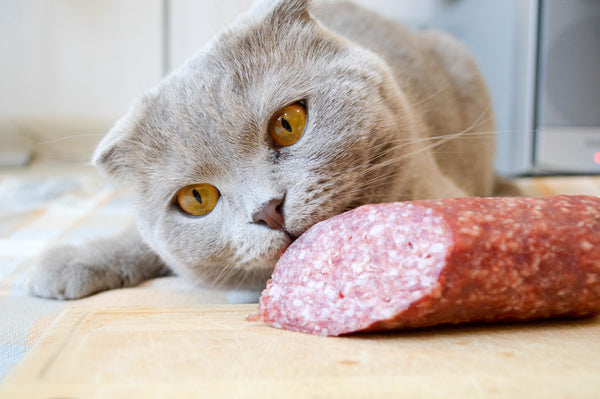
Often imported from central or eastern Europe, Hard Salami is usually made from beef or a beef-and-pork blend. It also has garlic powder, onion powder, mustard seed, curing salt, black pepper, and red pepper flakes. After being cured at 50°F to 60°F with about 80 to 90 percent humidity for two to three days, it’s smoked. Hard salami is mild in flavor with a firm, dry texture.
Cacciatore 
Meaning “hunter-style” in Italian, cacciatore is pocket-sized. It’s made with coarsely chopped pork, sherry wine, fresh garlic, and black pepper. Then it’s stuffed into a thin, natural casing and aged for 21 days. Cacciatore is aromatic and has a mild flavor.
Genoa salami 
Named for the birthplace of Christopher Columbus, Genoa salami is made from finely chopped pork, veal, or beef. It’s usually mixed with cracked black or white pepper, red wine, garlic, salt, and mace. Then it’s put into a large casing and aged for up to 60 days. It has an especially soft texture and acidic flavor.
Lardo 
Lardo is usually made from pork fatback that’s been rubbed down with salt, black pepper, and rosemary. It’s left to cure in a soupy brine for six months. It’s rich, creamy, and slightly sweet.
Pancetta 
Pancetta is pork belly that’s been rolled and seasoned with salt, pepper, and seasonings, such as juniper berries, coriander, and fennel seeds. It’s cured in a cool, dry place for two to three weeks. Commonly sold cubed, it has a dense, silky texture, and nutty flavor.
Pepperoni 
Pepperoni, which means “big peppers,” was created on Mulberry Street or Bleecker Street in Lower Manhattan in 1919. It’s made from beef and cured pork and then seasoned with chili peppers, garlic, fennel, mustard seeds, or paprika. After being injected with salt, sodium nitrate, and lactic acid (commonly used during the yogurt or cheese making process), it’s dried for 20 days.
Prosciutto 
Prosciutto, which translates to “ham” in Italian, is made from the hind legs of pigs and sea salt. It’s heavily salted and then cured for two months in a cool environment. Once the salt is washed from the meat, it’s left to dry age for at least 400 days. Prosciutto has a rich, sweet-salty flavor and silky texture.
Soppressata 

Soppressata is made from coarsely cut pork shoulder meat and fat. It's flavored with red wine, fennel seeds, Calabrian chile peppers, garlic, and black peppercorns. Then it's packed into large casings that are pressed into oblong shapes and aged for three to four weeks. It has a coarse grind with a firm, chewy texture and a spicy finish.



